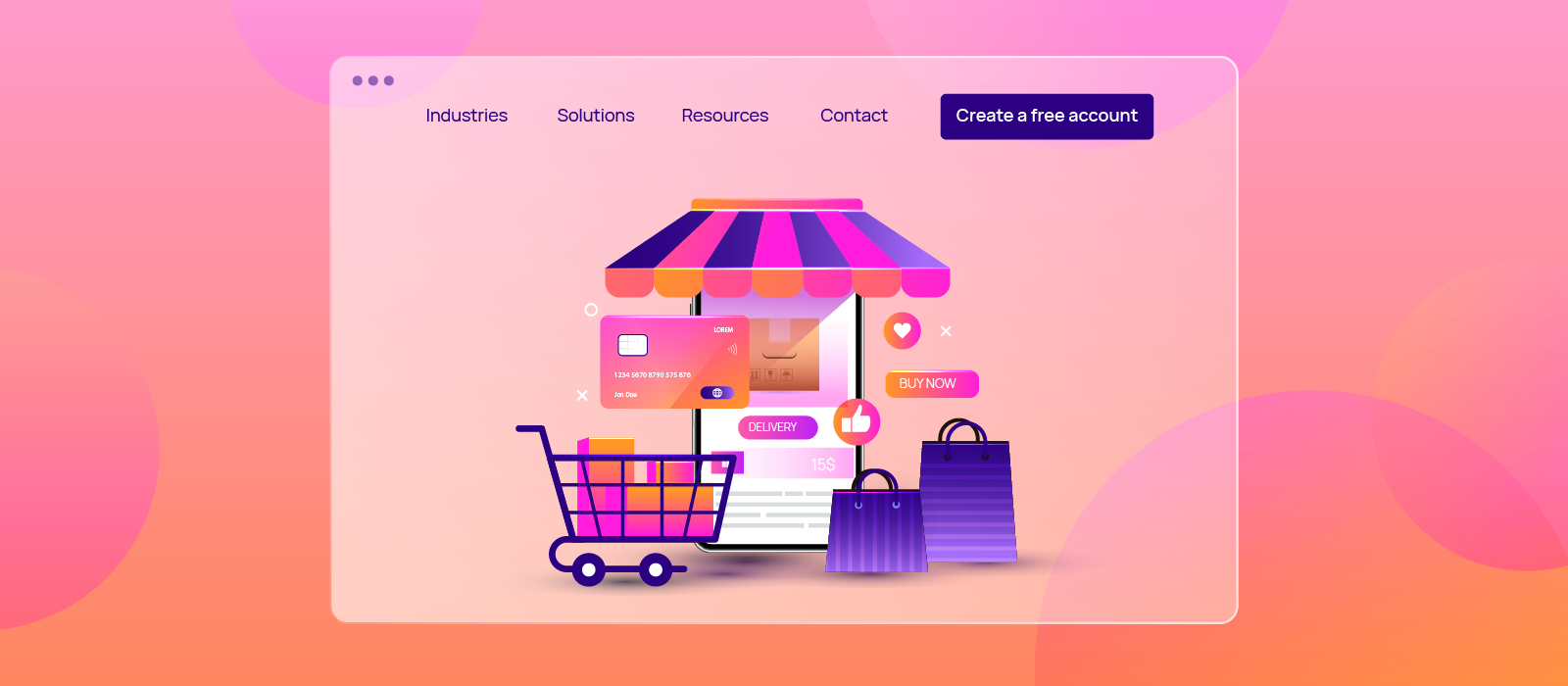UX UI Design Studio


For both B2B and B2C e-commerce businesses, having an effective website design is crucial. Studies by Social Media Today and WebFXResearch has shown that 94% of users’ first impressions are related to website design, and 75% of a website’s credibility is also judged based on its design. However, designing a B2B or B2C website requires different approaches, and any misuse can negatively impact business revenue.
What are the differences between B2B and B2C website design? Are there any practices to design websites better? Let’s discover through this blog!
B2B (Business-to-Business) and B2C (Business-to-Consumer) are two common e-commerce models. In B2B transactions, companies (often manufacturers or wholesalers) sell products or services to other businesses (often retailers), not directly to individual consumers. On the other hand, B2C transactions involve businesses selling products or services directly to individual customers. A well-known example of this is Amazon, which operates both a standard platform for individual customers and a specialized service called Amazon Business, catering specifically to business customers.
Both B2B and B2C e-commerce models have their own unique challenges and opportunities. B2B e-commerce tends to involve larger transactions, longer sales cycles, and more complex negotiations, while B2C e-commerce often involves smaller transactions, higher transaction volumes, and a greater focus on customer experience and Marketing.
B2B and B2C websites are designed to serve different purposes and audiences, and as a result, have distinct differences in their structure, content, and functionality. Here are some of the key differences between B2B and B2C websites.
B2B websites typically have a small customer base of businesses and organizations. Nonetheless, they tend to have higher order values and a greater likelihood of repeat business. B2B eCommerce websites are usually more complex and require specialized features such as credit terms, volume discounts, and integrations with other design business systems. These websites have strict security and compliance requirements as they handle sensitive business information such as contracts and pricing. To access and place orders, business users are commonly required to create an account and log in to the websites first.
By contrast, B2C websites target individual consumers and allow for anonymous browsing and purchasing. These websites have a larger customer base but with lower order values. They focus on ease of use and visually appealing design. The buying process for B2C is usually simpler and faster than B2B as it involves a single decision maker and a shorter sales cycle.
In terms of design and functionality, B2B websites tend to have a more professional and straightforward design. These websites have complex navigation and require specialized features such as account management, order tracking, and inventory management. They provide detailed product information, technical specifications, and case studies to support the decision-making process of other businesses.
In contrast, B2C websites create an immersive and engaging customer experience. They have a visually appealing design with images, videos, and interactive elements to showcase their products and services. Such design elements aim to create an emotional connection with customers, rather than just providing information. Their navigation is simple and user-friendly, with features such as wishlists, reviews, and ratings, to facilitate the decision-making process of individual customers.
Let’s take the example of Amazon and Amazon Business! While the navigation menus for Amazon Business are designed to make it easy for businesses to find products and services, with categories such as “Office Supplies,” “Industrial & Scientific,” and “Education Supplies.” The B2C Ecommerce platform, otherwise, has a more general navigation menu that includes categories such as “Electronics,” “Books,” and “Clothing.”
Additionally, Amazon Business offers advanced account management features with the ability to track their spending and purchasing history over time and create multiple users with different access levels, such as buyers, administrators, and payment approvers, which makes it easier for businesses to delegate purchasing responsibilities and manage their accounts more efficiently. Whereas, regular Amazon users can also manage their accounts but are not offered the same level of customization and flexibility as Amazon Business users.
It takes time for any business customers to consider and decide whether to purchase B2B products or services. To address this, B2B businesses continuously update their website content to include comprehensive buying guides, in-depth product videos, case studies, and blog posts. The primary goal is to educate and persuade potential customers about the value and effectiveness of their products.
As a comparison, B2C customers tend to have simpler considerations when searching for a product online. B2C websites typically offer high-quality product images, discounts, customer reviews and ratings, and social proof in the form of testimonials and review videos. In Vietnam, top B2C ecommerce platforms like Shopee, Lazada, and Tiki provide this information on their websites to provide a positive shopping experience and increase customer satisfaction. This is one of the reasons behind the impressive growth of Vietnam’s Ecommerce industry, expected to generate revenue of $13 Billion by 2023, making it the 26th largest market globally.
B2B businesses typically have variable pricing models that are based on the size of the purchase, while B2C pricing is generally consistent. B2B companies often negotiate prices with customers, and their websites may not display pricing upfront. Additionally, they may offer customized pricing for loyal customers and automated pricing calculators that instantly show price changes based on the order size.
In contrast, B2C pricing may utilize discounts such as coupons, sales, and special offers as common pricing customization methods. B2C websites typically provide upfront and transparent pricing, along with fields for entering coupon codes on checkout pages.
Looking back at the example of Amazon and Amazon Business! Both platforms offer competitive pricing, but Amazon Business has additional features such as bulk pricing and volume discounts, allowing businesses to purchase products at a lower cost when buying in larger quantities. Furthermore, eligible organizations also benefit from tax-exempt purchasing from Amazon Business to save a great amount of money, which is not applied to Amazon individual users.
The checkout process is the final stage of the customer journey, in which there are some differences between B2B and B2C platforms.
In B2B websites, the checkout process usually combines automated steps and live human assistance as B2B sales often involve high-stakes decisions. Given that, these websites typically offer:
Meanwhile, the B2C checkout process is usually straightforward. Customers select products, add to their shopping carts, enter any available coupon codes, confirm their delivery address, pay and receive an order confirmation. B2C websites commonly provide features including
The checkout process of both Amazon and Amazon Business requires users to create an account to make purchases, but Amazon Business requires additional account information such as a business name and tax ID number. In terms of payment, Amazon Business has more flexible options, including the ability to use purchase orders, request net payment terms, and pay via invoice. This makes it easier for businesses to manage their cash flow and pay for purchases on their own terms.
When building a website, optimizing UX (User Experience) should be prioritized, and one effective approach is through the design. You might have heard about common practices that can improve the design of a B2B and B2C e-commerce website, such as optimizing for mobile devices, using high-quality images, or adding social proofs (User Testimonials, Reviews, Case Studies,…). How about lesser-known tips that go beyond the basics? Here are some of them!
Micro-interactions are small design elements on your website that serve as visual cues and animations to provide feedback to users as they interact with your website. These small details can draw users’ attention and enhance website navigation, ultimately resulting in a more emotional and user-friendly website.
When implemented correctly, micro-interactions can have a significant impact on how users perceive your brand and influence their actions. Users may not even realize why they feel positively or negatively about a product or website, but their impression can significantly influence their overall experience.
White space, also known as negative space, is the area around design elements that can enhance the look and professionalism of your website. By using white space effectively, you can make your content more legible while also allowing the user to focus on the elements surrounding the text.
Crazy Egg’s statistics revealed that incorporating white space around text and titles can increase user attention by 20%, ultimately improving user engagement on your website. Additionally, white space can create a sense of openness, freshness, and modernity, which can communicate a positive brand image to users. However, since having too much white space can lead to the omission of valuable information, it’s essential for both B2B and B2C companies to strike the right balance between white space and content.
Headings play a critical role in guiding users through your website, allowing them to quickly and easily find the information they need. Search engines place more weight on headings, so it’s important to choose the right heading and make it stand out visually. A basic tip to keep in mind is to include relevant keywords in your headings. This can help attract the right audience and improve your search engine rankings.
When designing a navigation bar, consider the natural reading pattern from left to right. Place informational categories on the left so users can learn more before taking action. On the other hand, action categories like “Contact Us” should be on the right to allow users to take action after gathering information.
However, the home link should always be on the far left to allow users to return to the beginning quickly. This follows our natural instinct of using the rewind and fast-forward buttons on a remote. By following these simple guidelines, you can optimize your navigation bar for a better user experience.
According to VWO, incorporating photos of real humans on a website can positively impact visitors’ initial impression of trustworthiness. Similarly, another study found that adding a substantial photo of a person to a text-only landing page resulted in a 102.5% increase in conversions. These findings demonstrate the effectiveness of using human-centered images in website design.
However, the above A/B testing also revealed an interesting fact that the photos should be “real”. While a photo of the company’s staff or customers may be suitable, stock photos should be avoided as visitors can discern the difference, potentially diminishing their perception of trustworthiness.
You may want to read more about: What is Responsive Design? How to optimize Responsive Web Design?
Designing an e-commerce website that optimizes user journeys is not a one-size-fits-all approach for both B2B and B2C businesses, as it depends on the products and services offered. By following the tips mentioned earlier, businesses can achieve success in their website design projects.
Are your business still unsure how to create a website that meets your unique requirements? Let us help you! We are Lollypop Vietnam, the Top Web Design Agency Vietnam with years of experience in website and application design in various industries including B2B and B2C Ecommerce.
Contact us and bring the best version of your website to life!

